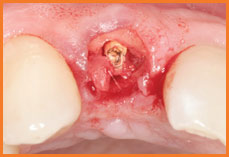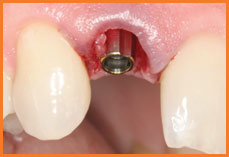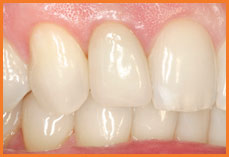An immediate dental implant requires planning and skill, in fact it requires team work between the patient – restorative dentist, implant surgeon and laboratory technician.
There is no question that given the current state of the art in dentistry, that dental implants are pretty much the best way to replace teeth; they are stand alone tooth replacement systems that look and function just like regular teeth. They do not attach to adjacent teeth like dental bridges and don’t have to be taken in and out like removable partial dentures.
A dental implant is a tooth root replacement made of titanium, which has the unique property of being osteophilic (osteo-bone, philic-loving) and actually fuses to bone. A dental crown, the part of the tooth that you see in your mouth, is attached to the implant. And the great thing about implants is they are not susceptible to decay or periodontal (gum) disease in the same way that teeth are.
Now here are a few important pointers, which hold for dental implants generally and are especially important in cases when replacing a front tooth for an imminent event like a wedding in which you need to look your best.
| ||||||||||||||||||||
Many times, a periodontist, oral surgeon or specially trained dentist can place an implant directly into the extraction socket immediately following tooth removal. It is imperative that the extraction of the failing tooth be performed very carefully and without damage to the surrounding gum and bone tissue. This is known as an “immediate” replacement implant. Traditionally the socket is allowed to heal and fill in with new bone first before an implant is placed into it.
The benefit to having an implant placed “immediately” is that only a single surgical procedure is necessary as opposed to two separate procedures. Dental implant success is dependent upon initial stabilization and immobilization in the bone, meaning there should be no movement of the implant at all. This is critical to the fusion of the implant with the bone. Initially, the implant is held securely in place by mechanical forces. As the implant heals, it forms a microscopic bond with the surrounding bone which is known as osseointegration (osseo-bone, integration – to become one with).
It is more difficult to place and secure an implant at the time of tooth extraction because there is less bone available, and the security comes from being able to fit the implant as closely as possible into the remaining socket and to the bone beyond it (where the extracted tooth root ended). This is especially important in the front of the mouth where the teeth show more in what we dentists call the “esthetic zone”. The procedure carries some risk, but is quite predictable in the hands of an experienced surgeon.
A crown, usually “provisional” in nature can also be placed immediately. This makes it all the more critical to have an initially stable, non-movable implant, because a crown placed immediately will tend to destabilize the implant with biting forces. The provisional crown therefore needs to be made so that it really doesn’t contact the teeth in the opposing jaw so you can’t bite or eat on it for a period of time – this means the new tooth is initially there just for social appearances. We call it a “provisional” crown, since we need to wait until we know that the implant has fully osseointegrated, a matter of 2 – 6 months, before making a final permanent crown. That way we can be assured that not only the bone, but also the gum tissue are stable and fully healed; that the gum level and the “papillae”, the little pink triangular gum that adequately fills the space between the implant crown and adjacent teeth. This can indeed result in a very esthetic, functional and long term tooth replacement.
If you enjoyed this article, there is a good chance you will like these articles from my blog as well:
- “What Are Dental Implants“
- “Dental Implant Success Rates”
- “How To Make Dental Implant Crowns Look Natural“
- “Metal Free Ceramic Dental Implants“
Thanks for Reading !!



Comments